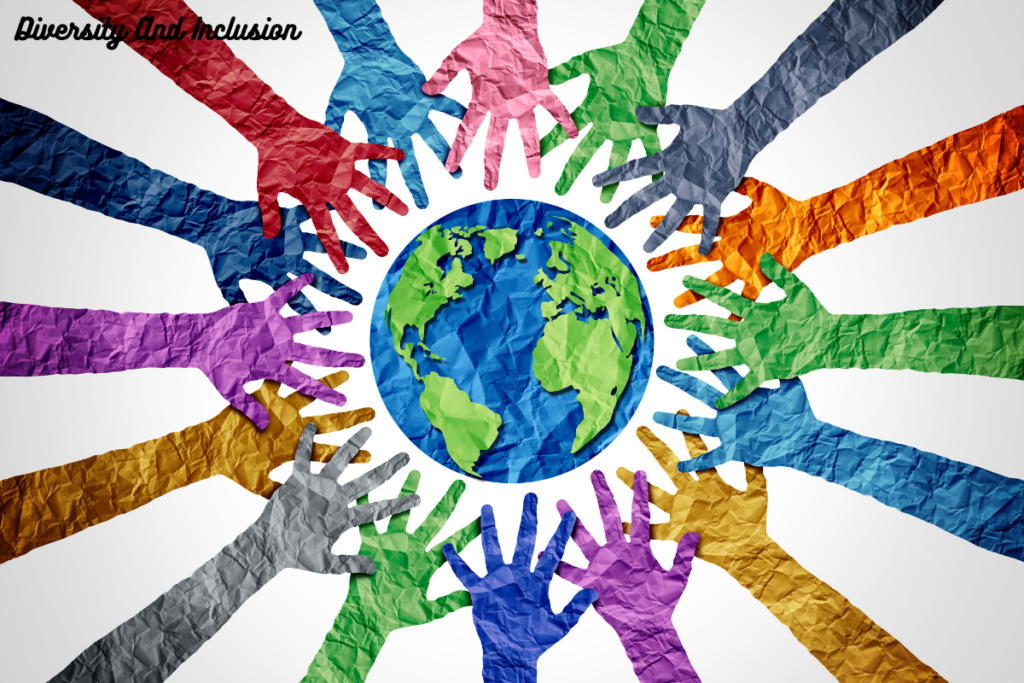Introduction: Diversity And Inclusion: From Buzzword to Business Imperative

“Diversity and Inclusion: From Buzzword to Business Imperative” is important because it highlights how important it is to embrace diversity and create an inclusive workplace.
Diversity includes differences in color, ethnicity, gender, age, sexual orientation, religion, and physical abilities. On the other hand, inclusion aims to establish a polite, encouraging atmosphere that recognizes and benefits from these distinctions.
The term “Diversity and Inclusion” has become more popular recently as businesses realize the many advantages it offers the workplace. A greater variety of viewpoints and ideas, enhanced creativity and innovation, enhanced employee engagement and retention, and improved decision-making are some of these advantages. By prioritizing diversity and inclusion, businesses may boost growth, reputation, and profits.
Overall, the key to developing a more just and productive workplace is turning diversity and inclusion from platitudes to core elements of an organization’s culture.
Table of Contents
Diversity and Inclusion And its Meaning:
Diversity is environmental variation. Race, gender, age, ethnicity, sexual orientation, handicap, socioeconomic status, religion, and culture are among the many human traits covered by this. Diversity in the workplace refers to the presence of different groups of individuals and the variety of viewpoints they bring to the table.
Conversely, inclusion refers to how well the contributions, viewpoints, and ideas of various people are included into the surroundings. It is the process of establishing an atmosphere in which everyone is treated with respect, feels appreciated, and is free to engage completely. By ensuring inclusion, varied people are given a seat at the table and the freedom to express their special perspectives without worrying about prejudice or marginalization. The critical message is that “The Future of Work is Inclusive,” motivates organizations and individuals to take active steps toward fostering diversity and inclusivity in the workplace.

Importance of Diversity and Inclusion in the Workplace:
“Diversity and inclusion” (D&I) has become essential in today’s business environment for developing inventive, successful, and dynamic work environments. These two interrelated ideas are essential for promoting a productive and enjoyable work environment as well as for advancing the expansion and sustainability of businesses.
Diverse viewpoints and experiences are brought together by diversity. When people from various backgrounds work together, they provide original ideas and methods for tackling problems. By making sure that these many viewpoints are acknowledged and heard, inclusion promotes an innovative and creative culture that may result in the creation of new goods, services, and solutions.
Enhances creativity and innovation by bringing varied perspectives to the table:
More and more contemporary companies are realizing that promoting diversity and inclusion (D&I) offers major competitive advantages in addition to justice and equality. Innovation and creativity are enhanced in a diverse and inclusive workplace, which is one of its most attractive advantages.
This result is a result of diversity’s richness of diverse perspectives and an inclusive atmosphere that encourages everyone to share their special thoughts and points of view.
Varied Perspectives:
Diversity in the workplace unites people with various experiences, backgrounds, and points of view. Employees are more creative and innovative because they are able to approach problems from a variety of perspectives. Diverse teams bring together people with various perspectives on the world. The distinct experiences and backgrounds of each team member influence their way of thinking, approaching issues, and coming up with ideas.
Due to the diversity of viewpoints, solutions are examined from a number of aspects, producing more thorough and original results.
Boosts employee morale and engagement, leading to higher productivity:

Promoting diversity and inclusion (D&I) in the workplace has become essential in the current era. It is no longer just an ethical duty; it is also a significant factor in employee engagement, morale, and productivity. These interrelated ideas have a profound effect on the work environment and have a big impact on how people feel and perform.
Employees who work in diverse teams are exposed to a range of viewpoints and ideas, which enhances their work experience and makes their jobs more fulfilling and intellectually stimulating.
One of the basic needs of companies is “diversity in tech”, since it promotes important engagement elements like open communication and active participation. Employees who feel heard and included are more likely to be involved with their work and committed to the goals of their team.”
Inclusive Environment:
Every employee will feel appreciated and accepted for who they are if inclusion is practiced. Employee morale rises and job satisfaction and engagement levels rise when they feel valued, supported, and included. Higher job satisfaction is a result of inclusive policies including appreciating and celebrating diversity, offering fair opportunities for advancement, and encouraging teamwork and support. Employee retention rates are higher when workers are happy, which lowers turnover and related expenses.
Companies can benefit from the multitude of diverse viewpoints that workers bring, increase morale and engagement, and create an environment where people feel free to express themselves and their best work when they embrace diversity and promote inclusiveness.
Fosters a more positive company culture and better talent retention:
Diversity and inclusion (D&I) are critical components in today’s cutthroat business environment for fostering a positive workplace culture and improving talent retention. Workplaces where employees feel appreciated, respected, and supported are typically created by organizations that place a high priority on diversity and inclusion. This is important because it fosters a vibrant organizational culture and long-term employee commitment.
Diversity efforts foster an environment of respect for individual diversity, motivating staff members to recognize and cherish the distinctive viewpoints of their peers. By ensuring that everyone feels heard and that their contributions count, inclusion promotes equity and mutual respect in society.
Positive Work Environment:
Organizations foster a healthy work environment wherein all employees are welcomed and feel valued by encouraging diversity and inclusion. Top talent is drawn to this inclusive atmosphere, which also helps retain staff members because they are more inclined to stick around in a setting where they are respected and encouraged.
Initiatives promoting diversity frequently include open recruiting, promotion, and dispute resolution procedures, which foster employee trust. Ensuring that all workers may participate honestly, accept constructive criticism, and develop is ensured by inclusive policies, which strengthen an honest and open work environment.

Strategies for Promoting Diversity and Inclusion:
Workplace diversity and inclusion (D&I) calls for intentional, continuous initiatives. Businesses that use D&I initiatives gain substantial commercial advantages like improved innovation, employee engagement, and talent retention in addition to fostering a more fair and joyful work environment. Leaders need to show their commitment to and support of D&I efforts.
This can be proven by making public remarks, taking part in D&I events, and allocating funds and resources for D&I initiatives. Set quantifiable, precise objectives for D&I. Review progress on a regular basis and hold leaders responsible for accomplishing these goals. Surveys of employee happiness, promotion rates, and diversity in hiring could all be considered metrics.
Implementing Inclusive Hiring Practices:
Integrating diversity and inclusion (D&I) into the employment process is essential to creating a workplace that is really diverse and inclusive. Employers that use inclusive recruiting methods are guaranteed to draw in and choose applicants with a diverse range of experiences, ethnicities, and viewpoints. This incorporates a variety of perspectives and ideas, which not only improves the culture of the workplace but also spurs creativity and financial success.
The likelihood of identifying the best applicant for the job increases when there are a variety of backgrounds, experiences, and skill sets among the candidates in diverse talent pools. By attracting candidates who might have previously felt excluded or neglected, inclusive recruiting ensures a more just and equitable hiring process.
Attracting Diverse Candidates:
Unconscious prejudice can result in discriminatory employment procedures where some groups are given preference over others. The goal of inclusive hiring procedures is to lessen these prejudices. It is made possible for all candidates to be assessed equally and on the basis of merit by using standardized procedures and diverse hiring panels.
Organizations can attract a wider range of candidates with different backgrounds and experiences by using inclusive hiring strategies, such as eliminating bias from job descriptions, using diverse interview panels, and actively recruiting from underrepresented groups.
Providing Diversity Training and Education:
Fostering a happy, inventive, and productive workplace requires a strong focus on diversity and inclusion, or D&I. Offering thorough diversity education and training programs is essential to advancing D&I.
These programs aim to improve staff members’ knowledge, comprehension, and abilities about diversity while also promoting an inclusive workplace where all individuals can prosper.
Building Awareness:
Employees are taught inclusive practices including empathy, polite communication, and active listening in training programs. Stronger teams that encourage diversity of opinion and give everyone a sense of being heard are formed through improved communication skills.
Providing diversity education and training to staff members contributes to a greater understanding of cultural variety, unconscious prejudice, and the value of inclusivity. Employees are better equipped as a result to appreciate and comprehend workplace diversity.
Creating Employee Resource Groups:
Employee Resource Groups (ERGs) are employee-led, volunteer organizations with the goal of promoting an inclusive and diverse work environment. These groups unite workers who have similar experiences, histories, or interests and offer a forum for advocacy, professional growth, and support among themselves and other employees.
By fostering positive cultural change, increasing knowledge of diversity concerns, and fostering connections among employees, ERGs play a crucial role in advancing diversity and inclusion (D&I).
Employee resource groups (ERGs) give workers from underrepresented groups a forum to interact, exchange stories, and promote inclusivity inside the company. These groups provide employees who might feel marginalized with assistance, networking opportunities, and a sense of belonging.
Obtain support from top management and designate executive sponsors who can champion the ERGs, offer direction, and guarantee alignment with company objectives. By participating in events, advocating for ideas, and praising the accomplishments of ERG members, leadership should openly promote ERG activities.
By putting these tactics into practice, businesses may actively encourage diversity and inclusion, foster a more inclusive and inviting work environment, and provide employees the freedom to share their special viewpoints in order to foster success and innovation.
Benefits of Embracing Diversity and Inclusion:
Diversity and inclusion (D&I) are considered strategic benefits that firms can use to improve performance and achieve long-term success in the fast-paced, worldwide corporate environment of today.
Embracing diversity and inclusion (D&I) entails creating an environment at work where people feel appreciated for who they are and can contribute to the maximum extent possible.
Improved Decision-Making:
Including diversity and inclusion (D&I) in the workplace has major positive effects on decision-making processes in addition to being fair. Better decision-making can result from embracing diversity in all of its manifestations and creating an inclusive atmosphere where all opinions are respected and heard.
Here are some ways that D&I can influence organizational decision-making in a good way:
Wide Range of Viewpoints:
Having a team with a range of viewpoints, experiences, and backgrounds is a sign of embracing diversity. Decision-makers can make more creative and well-informed choices that take into account a variety of factors and possible outcomes when they take into account a broad spectrum of opinions.
Better Understanding and Engagement with Diverse Customer Bases:
In order to effectively understand and interact with a broad client base, firms need to embrace diversity and promote inclusive practices in today’s interconnected and multicultural world.
Businesses can strengthen their relationships with consumers from many backgrounds, improve their cultural competency, and customize their goods and services to satisfy a broad spectrum of clientele by placing a high priority on diversity and inclusion in their strategy.
Cultural Competence:
A varied workforce is more able to relate to and comprehend a wider spectrum of clients, including individuals from various cultural origins. With a variety of clientele, this cultural competency promotes better interaction, communication, and relationship-building.
Adopting a diversity and inclusion policy improves an organization’s cultural competency, allowing staff members to interact and comprehend consumers from a wider range of backgrounds. Effective communication and relationship-building with consumers are facilitated by inclusive practices, which increase customer trust and loyalty.
Enhanced Reputation and Attractiveness to Top Talent:
An organization’s reputation and capacity to draw in and keep top personnel can be greatly impacted by its embrace of diversity and promotion of an inclusive workplace culture. Companies can establish a favorable brand image, show a dedication to justice and fairness, and foster an environment that attracts a wide pool of highly competent people by giving priority to diversity and inclusion efforts.
Positive Employer Brand:
Top talent seeking inclusive work environments is drawn to companies recognized for their dedication to diversity and inclusion. Companies that promote inclusion and diversity attract skilled people who value workplace equity and diversity.
Embracing diversity and inclusion has several advantages, such as better decision-making, closer relationships with clients from all backgrounds, and the capacity to draw in top talent, all of which eventually support the success and expansion of the company.
Overcoming Challenges in Diversity and Inclusion Efforts:
For companies hoping to establish fair and inclusive work environments, navigating the obstacles in diversity and inclusion (D&I) initiatives is essential. Organizations can create a diverse and inclusive workplace where everyone feels appreciated, valued, and supported by tackling these challenges head-on and putting measures in place to get past them.
Addressing Unconscious Biases:
Promoting diversity and inclusion (D&I) in workplaces requires addressing unconscious biases. Implicit biases, another name for unconscious biases, are ingrained prejudices or attitudes that subtly influence our perceptions, choices, and behaviors. Organizations can foster a more equal, inclusive, and inviting work environment for all employees by actively detecting and addressing these prejudices.
Training and Awareness Programs:
Educating staff members about unconscious bias increases their awareness of the preconceived notions that influence their decisions and actions. Employees might attempt to lessen these biases’ effects at work by discussing and admitting them.
Creating a Safe Space for Open Dialogue:
Everyone can feel free to share their ideas and emotions in a safe environment that values variety and inclusiveness without worrying about prejudice or condemnation. This makes people feel like they belong and makes it possible for meaningful conversations to occur, which eventually increases people’s empathy and understanding of one another.
Encouraging Discussion and Feedback:
Facilitating a secure and welcoming workplace where staff members are at ease talking about diversity-related matters encourages candid communication. Encouraging feedback facilitates productive dialogue, understanding of diverse viewpoints, and problem-solving for diversity-related issues.
Holding Leadership Accountable:
In the context of “Diversity and Inclusion,” “Holding Leadership Accountable” refers to making sure that leaders actively support and foster inclusion and diversity within their businesses.
Leaders are essential to creating a culture that values diversity and inclusion. They are in charge of putting these ideals into effect through policies and procedures and set the example for the rest of the organization.
In order to be held accountable in this regard, executives must encourage diversity and inclusion in their hiring procedures, organizational structures, decision-making procedures, and general corporate culture. This entails actively seeking out various viewpoints, dealing with prejudice and discrimination, and fostering environments that support the success of underrepresented groups.
Driving Diversity and Inclusion Initiatives:

Supporting initiatives aimed at promoting diversity and inclusion requires strong leadership. Organizations may show that they are committed to establishing a diverse and equitable workplace for all workers by holding executives accountable for spearheading efforts, establishing diversity goals, and cultivating an inclusive culture.
Organizations can overcome obstacles in their attempts to promote diversity and inclusion, foster an inclusive workplace, and pave the way for ongoing progress toward diversity and equality objectives by putting these tactics into practice.
Conclusion:
“Diversity And Inclusion: From Buzzword to Business Imperative” concludes by highlighting how crucial it is for firms to embrace diversity and promote inclusion. The discussion focuses on how diversity and inclusion are essential building blocks that may inspire creativity, business success, and a great workplace culture.
The fundamental tenet of “Diversity and Inclusion” is the recognition and appreciation of human differences, be they related to color, ethnicity, gender, age, sexual orientation, religion, or other factors. Organizations that embrace diversity can access a multitude of diverse viewpoints, experiences, and skills that foster innovation, creativity, and improved decision-making.
An inclusive workplace where everyone feels appreciated, supported, and included boosts morale, engagement, and productivity. Establishing a work environment that prioritizes “Diversity and Inclusion” not only improves job happiness but also helps employers retain talent and build a better reputation.
Organizations can advance on their “Diversity and Inclusion” path by overcoming obstacles such confronting unconscious prejudices, promoting open communication, and holding leadership accountable. In the end, the dedication to “Diversity and Inclusion” is not only a moral requirement but also a calculated business move that can result in improved output, closer bonds with clients and staff, and a competitive advantage in the marketplace.
People also ask:
Diversity and inclusion boost innovation, decision-making, talent attraction, employee engagement, and morale, improving productivity and financial success. varied and inclusive workplaces can better understand and serve varied customers, giving them an edge in a fast-changing market.
In the corporate world, inclusion is fostering a culture where everyone is treated with respect, feels appreciated, and is encouraged to make a contribution. To promote creativity and development, diversity entails accepting variations in experiences, backgrounds, and viewpoints.